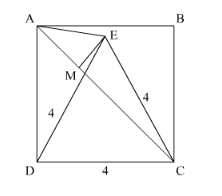ABCD is a square of side 4 cm. If E is a point in the interior of the square such that ΔCED is equilateral, then area of Δ ACE is
(a) $2 \sqrt{3}-1 \mathrm{~cm}^{2}$
(b) $4 \sqrt{3}-1 \mathrm{~cm}^{2}$
(c) $6 \sqrt{3}-1 \mathrm{~cm}^{2}$
(d) $8 \sqrt{3}-1 \mathrm{~cm}^{2}$
We have the following diagram.

Since $\triangle$ CED is equilateral,
Therefore,
$\mathrm{EC}=\mathrm{CD}=\mathrm{DE}=4 \mathrm{~cm}$
Now, $\angle \mathrm{ECD}=60^{\circ}$
Since AC is diagonal of sqr.ABCD
Therefore,
$\angle \mathrm{ACD}=45^{\circ}$
Therefore we get,
$\angle \mathrm{ECA}=\angle \mathrm{ECD}-\angle \mathrm{ACD}$
$=60^{\circ}-45^{\circ}$
$=15^{\circ}$
Now, in $\triangle \mathrm{ACE}$, draw a perpendicular EM to the base AC.
So in $\triangle \mathrm{EMC}$,
$\sin 15^{\circ}=\frac{E M}{E C}$
$=\frac{E M}{4}$
Therefore,
$\mathrm{EM}=\sqrt{2}(\sqrt{3}-1)$
Now in $\triangle \mathrm{AEC}$,
$a r(\triangle \mathrm{AEC})=\frac{1}{2}(\mathrm{AC})(\mathrm{EM})$
$=4(\sqrt{3}-1) \mathrm{cm}^{2}$
So the answer is (b)
